Abstract
A prospective trial was conducted to compare the effects of conservative management of prolonged pregnancy (conservative group) with routine induction of labour at 42 weeks' gestation (active group) in otherwise uncomplicated pregnancies. Of the 402 pregnancies studied, 207 (51%) were allocated to conservative management and 195 (49%) were allocated to have labour induced. The groups were well matched for age, parity, and smoking habits. One hundred and sixty six (80%) of the patients in the conservative group went into spontaneous labour. Of the remainder, two underwent elective caesarean section, 19 had labour induced because of clinical concern, and the remaining 20 had labour induced at the patient's own request. One hundred and twenty five (64%) of the patients in the planned active group underwent induction of labour. Of the remaining 70, 49 went into spontaneous labour and 21 (11%) asked that they should not have labour induced. Comparison of the two groups showed no difference in the length of the first stage of labour but a trend towards an increased need for intervention for fetal distress (p less than 0.06) in the active group. There were no differences in the length of the second stage, the need for intervention, or the mode of delivery. In terms of Apgar scores the neonatal outcome was not significantly different between the two groups, but a greater proportion of the babies (15% v 8%) in the active group required intubation. Umbilical cord venous pH estimated in the last 183 consecutive deliveries in the study showed a significantly lower mean value in the active group (p less than 0.05). There was no difference in birth weight between the two groups. Two deaths occurred in the study. There was a stillbirth in the conservative group at 292 days after massive abruption, and one neonatal death in the active group owing to multiple congenital abnormalities. The outcome for mother and baby in patients from both groups who went into spontaneous labour was generally good. The outcome for patients for whom conservative management was planned but induction became necessary was no different from that of patients who underwent planned induction at term. Thus from our results we can find no evidence to support the view that women with normal prolonged pregnancy should undergo routine induction of labour at 42 weeks' gestation.
Full text
PDF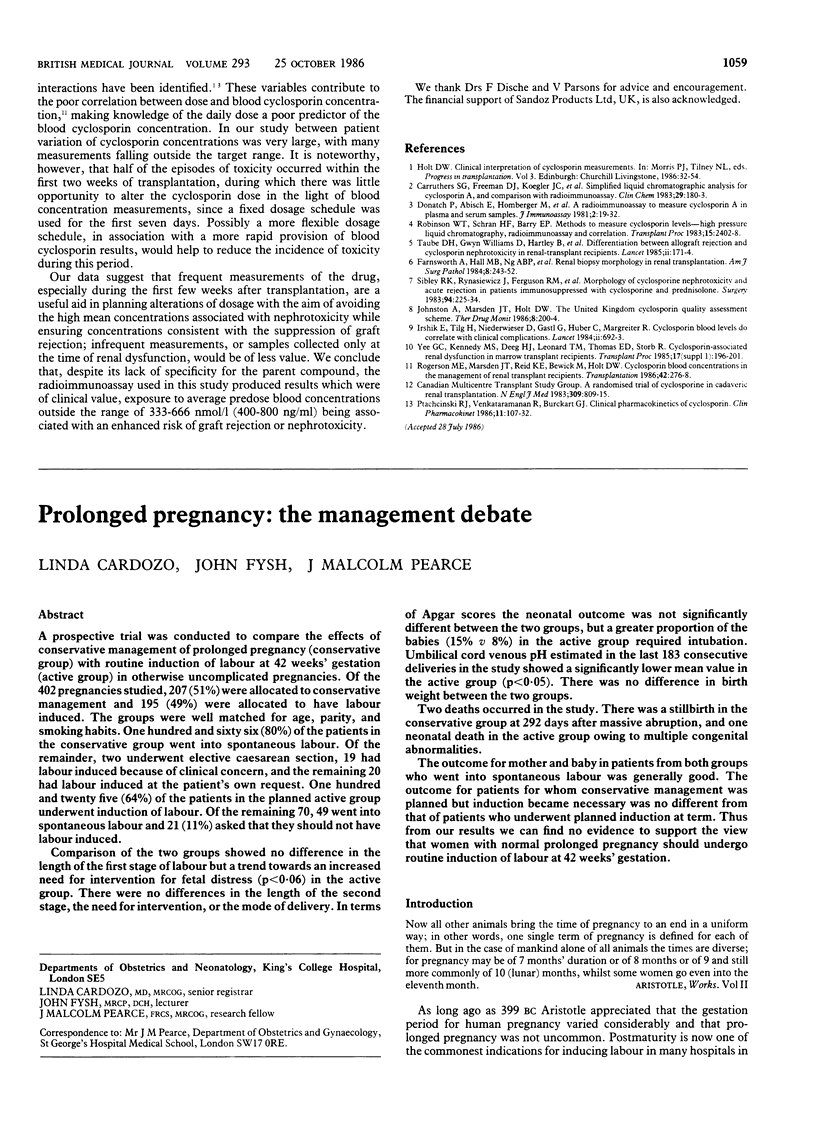
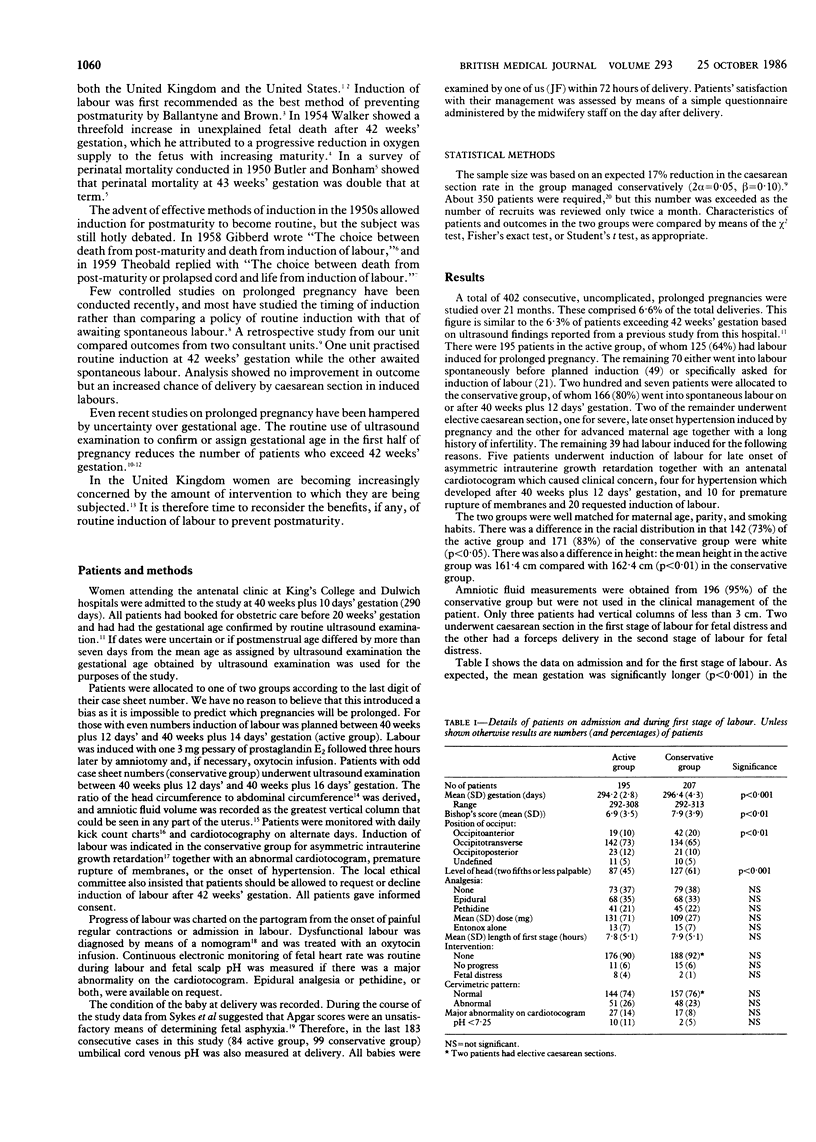
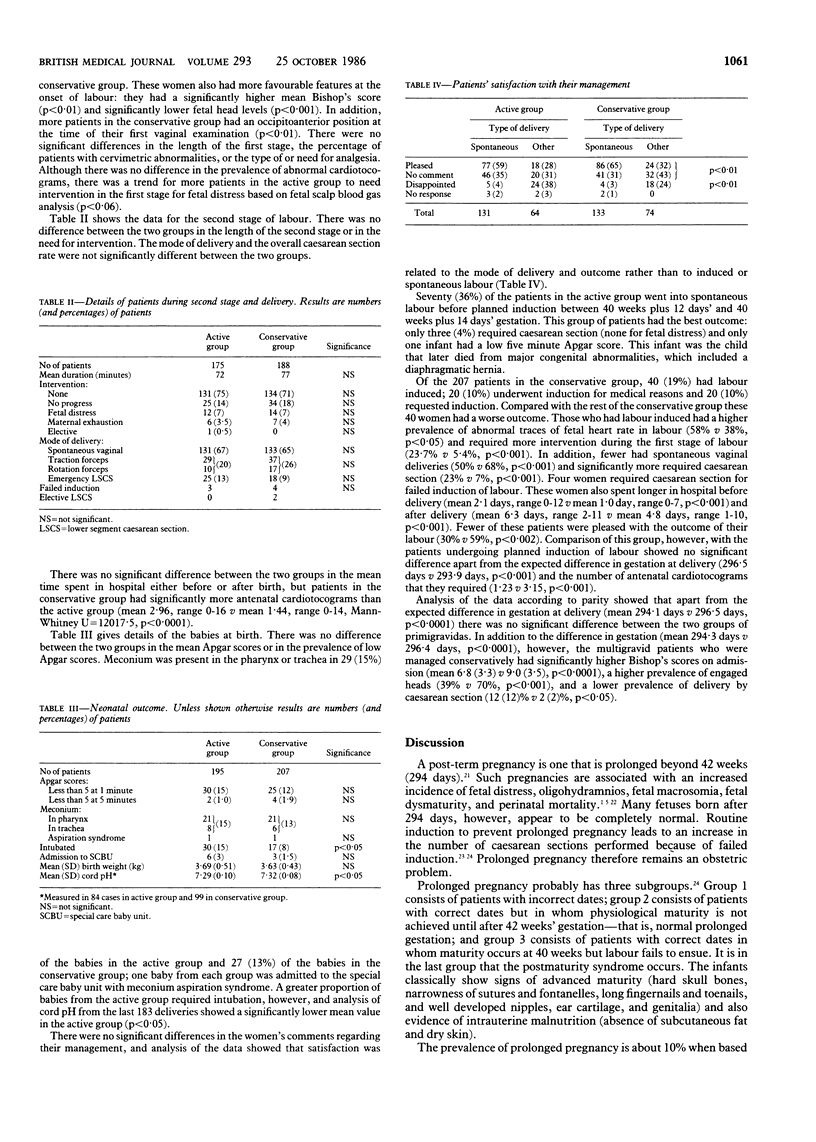
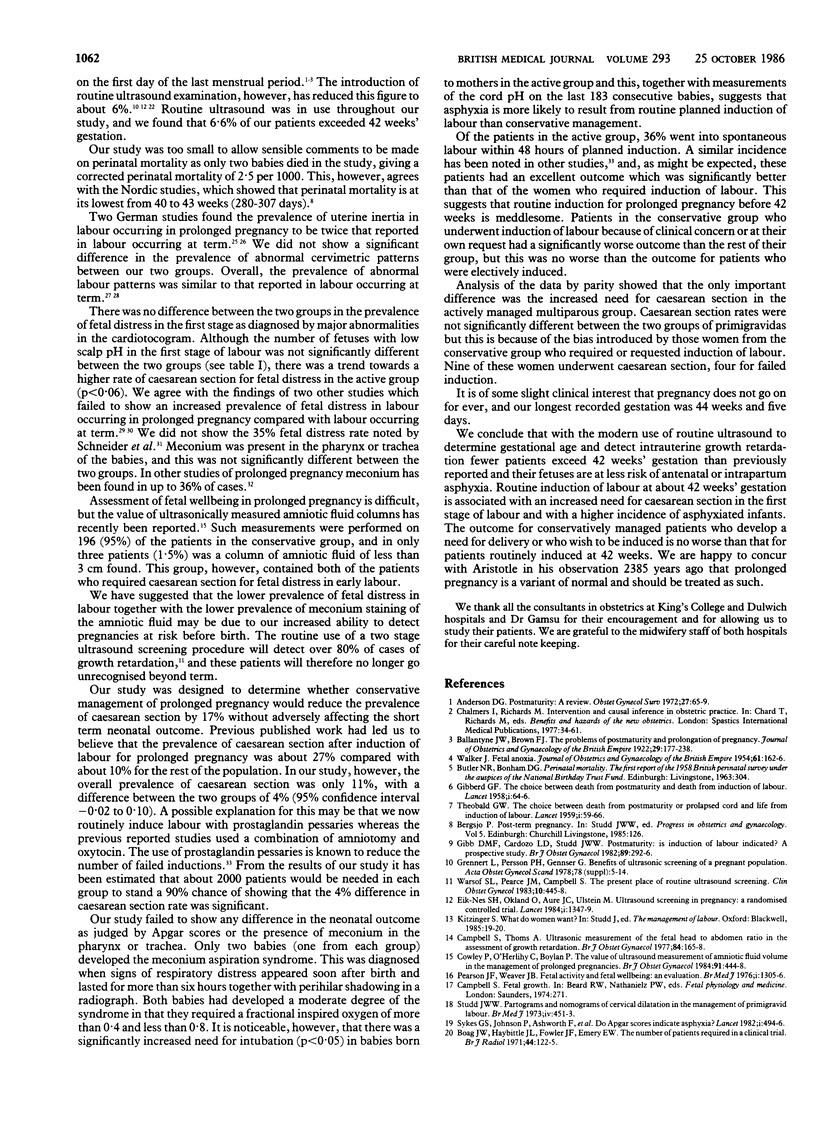
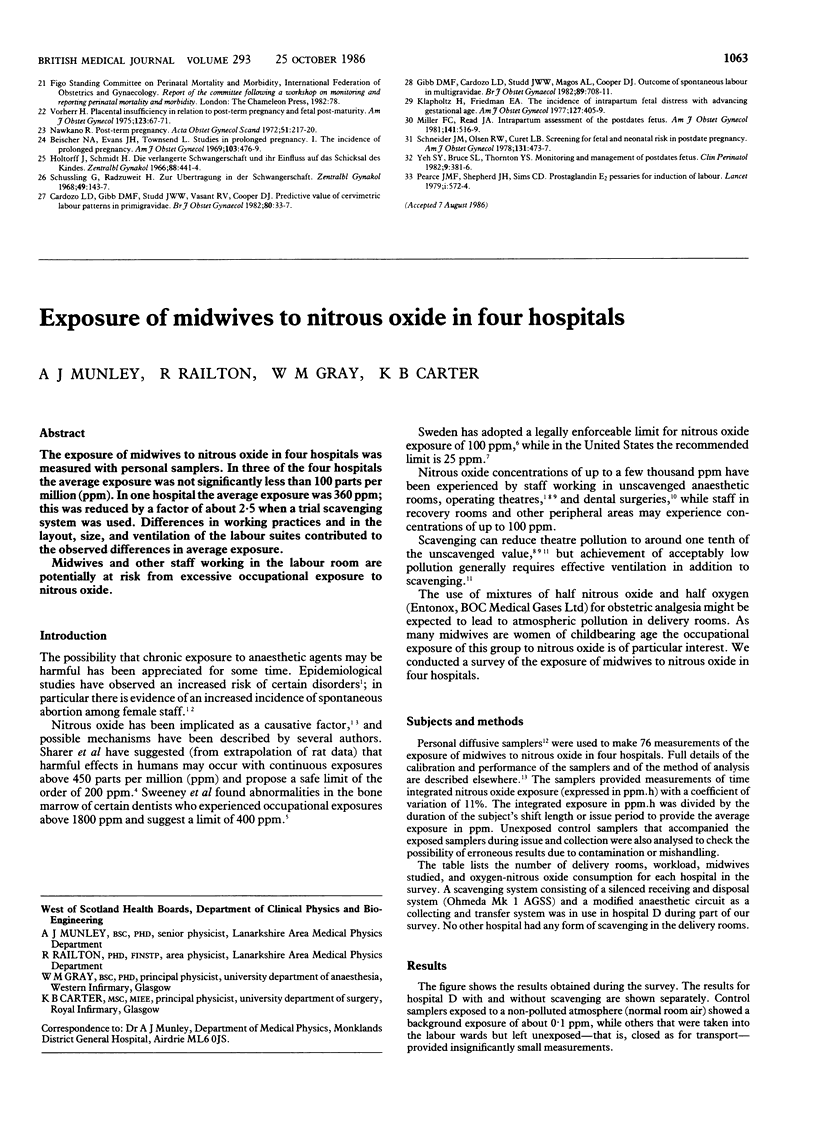
Selected References
These references are in PubMed. This may not be the complete list of references from this article.
- Anderson G. G. Postmaturity: a review. Obstet Gynecol Surv. 1972 Feb;27(2):65–73. doi: 10.1097/00006254-197202000-00001. [DOI] [PubMed] [Google Scholar]
- Beischer N. A., Evans J. H., Townsend L. Studies in prolonged pregnancy. I. The incidence of prolonged pregnancy. Am J Obstet Gynecol. 1969 Feb 15;103(4):476–482. doi: 10.1016/s0002-9378(15)31849-4. [DOI] [PubMed] [Google Scholar]
- Boag J. W., Haybittle J. L., Fowler J. F., Emery E. W. The number of patients required in a clinical trial. Br J Radiol. 1971 Feb;44(518):122–125. doi: 10.1259/0007-1285-44-518-122. [DOI] [PubMed] [Google Scholar]
- Campbell S., Thoms A. Ultrasound measurement of the fetal head to abdomen circumference ratio in the assessment of growth retardation. Br J Obstet Gynaecol. 1977 Mar;84(3):165–174. doi: 10.1111/j.1471-0528.1977.tb12550.x. [DOI] [PubMed] [Google Scholar]
- Eik-Nes S. H., Okland O., Aure J. C., Ulstein M. Ultrasound screening in pregnancy: a randomised controlled trial. Lancet. 1984 Jun 16;1(8390):1347–1347. doi: 10.1016/s0140-6736(84)91834-8. [DOI] [PubMed] [Google Scholar]
- GIBBERD G. F. The choice between death from postmaturity and death from induction of labour. Lancet. 1958 Jan 11;1(7011):64–66. doi: 10.1016/s0140-6736(58)92565-0. [DOI] [PubMed] [Google Scholar]
- Gibb D. M., Cardozo L. D., Studd J. W., Cooper D. J. Prolonged pregnancy: is induction of labour indicated? A prospective study. Br J Obstet Gynaecol. 1982 Apr;89(4):292–295. doi: 10.1111/j.1471-0528.1982.tb04698.x. [DOI] [PubMed] [Google Scholar]
- Gibb D. M., Cardozo L. D., Studd J. W., Magos A. L., Cooper D. J. Outcome of spontaneous labour in multigravidae. Br J Obstet Gynaecol. 1982 Sep;89(9):708–711. doi: 10.1111/j.1471-0528.1982.tb05095.x. [DOI] [PubMed] [Google Scholar]
- Grennert L., Persson P. H., Gennser G. Benefits of ultrasonic screening of a pregnant population. Acta Obstet Gynecol Scand Suppl. 1978;78:5–14. doi: 10.3109/00016347809162696. [DOI] [PubMed] [Google Scholar]
- Holtorff J., Schmidt H. Die verlängerte Schwangerschaft und ihr Einfluss auf das Schicksal des Kindes. Zentralbl Gynakol. 1966 Apr 9;88(15):441–456. [PubMed] [Google Scholar]
- Klapholz H., Friedman E. A. The incidence of intrapartum fetal distress with advancing gestational age. Am J Obstet Gynecol. 1977 Feb 15;127(4):405–407. doi: 10.1016/0002-9378(77)90498-7. [DOI] [PubMed] [Google Scholar]
- Miller F. C., Read J. A. Intrapartum assessment of the postdate fetus. Am J Obstet Gynecol. 1981 Nov 1;141(5):516–520. doi: 10.1016/s0002-9378(15)33271-3. [DOI] [PubMed] [Google Scholar]
- Nakano R. Post-term pregnancy. A five-year revieww from Osaka National Hospital. Acta Obstet Gynecol Scand. 1972;51(3):217–222. doi: 10.3109/00016347209156849. [DOI] [PubMed] [Google Scholar]
- Schneider J. M., Olson R. W., Curet L. B. Screening for fetal and neonatal risk in the postdate pregnancy. Am J Obstet Gynecol. 1978 Jul 1;131(5):473–478. doi: 10.1016/0002-9378(78)90105-9. [DOI] [PubMed] [Google Scholar]
- Studd J. Partograms and nomograms of cervical dilatation in management of primigravid labour. Br Med J. 1973 Nov 24;4(5890):451–455. doi: 10.1136/bmj.4.5890.451. [DOI] [PMC free article] [PubMed] [Google Scholar]
- THEOBALD G. W. The choice between death from postmaturity or prolapsed cord and life from induction of labour. Lancet. 1959 Jan 10;1(7063):59–65. doi: 10.1016/s0140-6736(59)91135-3. [DOI] [PubMed] [Google Scholar]
- Vorherr H. Placental insufficiency in relation to postterm pregnancy and fetal postmaturity. Evaluation of fetoplacental function; management of the postterm gravida. Am J Obstet Gynecol. 1975 Sep 1;123(1):67–103. doi: 10.1016/0002-9378(75)90951-5. [DOI] [PubMed] [Google Scholar]
- WALKER J. Foetal anoxia; a clinical and laboratory study. J Obstet Gynaecol Br Emp. 1954 Apr;61(2):162–180. [PubMed] [Google Scholar]
- Warsof S. L., Pearce J. M., Campbell S. The present place of routine ultrasound screening. Clin Obstet Gynaecol. 1983 Dec;10(3):445–457. [PubMed] [Google Scholar]
- Yeh S. Y., Bruce S. L., Thornton Y. S. Intrapartum monitoring and management of the postdate fetus. Clin Perinatol. 1982 Jun;9(2):381–386. [PubMed] [Google Scholar]


